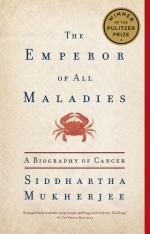
|
| Name: _________________________ | Period: ___________________ |
This quiz consists of 5 multiple choice and 5 short answer questions through Prologue; Part 1: A Suppuration of Blood.
Multiple Choice Questions
1. In 1937 President Franklin Delano Roosevelt signed the ________________ Act.
(a) National Cancer Institute.
(b) American Cancer Institute.
(c) American Cancer Society.
(d) National Cancer Center.
2. By the time Farber began his work in 1947, what had happened to the public outcry against cancer?
(a) It had grown.
(b) It had all but silenced.
(c) It had just begun.
(d) It had lessened somewhat.
3. One tenet is that all bodies are made up of cells. A second tenet is that cells arise only from what?
(a) Other cells.
(b) One cell.
(c) Nothing.
(d) A large group of cells.
4. Why does Mukherjee believe it is fortunate that Farber had not asked any of the pediatricians about creating an anti-leukemic drug?
(a) They would have told Farber they were already researching an anti-leukemia drug.
(b) They would have told Farber to involve them.
(c) They would have told Farber he was not experienced enough.
(d) They would have told Farber not to bother.
5. Virchow began to notice uncontrolled growth of cells. Virchow referred to this as _____________ or distorted growth.
(a) Alloplasia.
(b) Physioplasia.
(c) Neoplasia.
(d) Pseudoplasia.
Short Answer Questions
1. Robert would eventually die but he and many other patients had survived past the ______________ period. At the time, this was an eternity.
2. Mukherjee begins to discuss the age of cancer, referring to the ancient discoveries of ___________ in 2625 B.C.
3. In 1947, a pathologist named Sidney Farber waited impatiently in his laboratory for a parcel from _______________. Farber was a pediatric pathologist.
4. Minot's research pertained mostly to ________________ anemia.
5. Mukherjee was one of ____________ cancer fellows at the hospital involved in an immersive training program. Mukherjee describes the immersive training program as being so intensive that nothing outside of the hospital exists for the trainees. Residents eat, sleep and breathe medicine.
|
This section contains 300 words (approx. 1 page at 300 words per page) |

|




